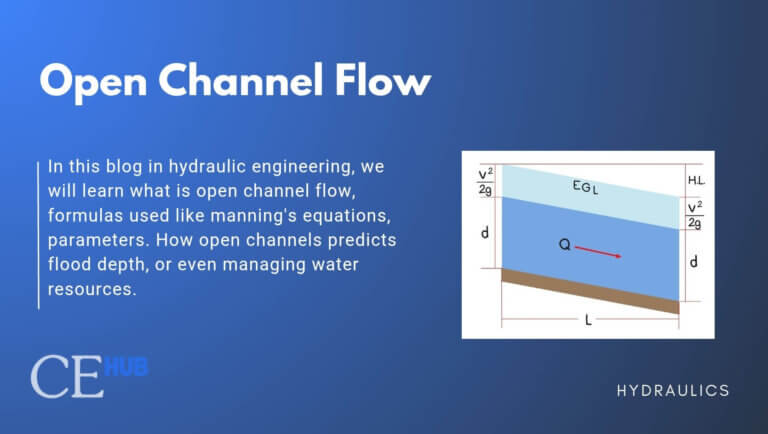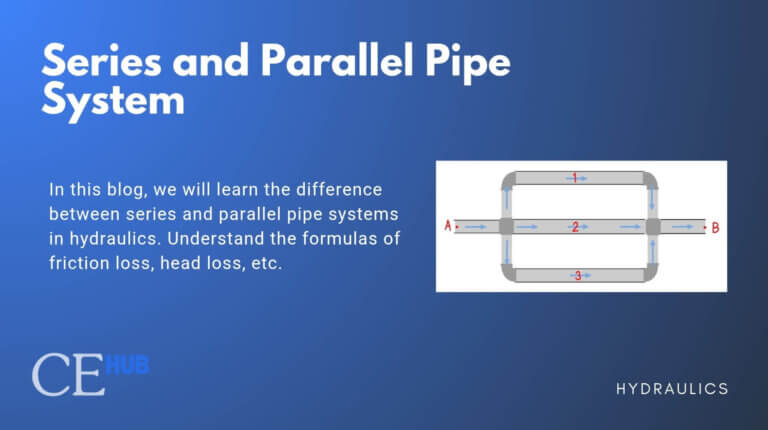Understanding Hydraulic Jumps
What is Hydraulic Jump?
A hydraulic jump occurs when rapidly flowing water at a shallow depth suddenly transitions to slowly flowing water at a greater depth. This abrupt change creates a dramatic turbulent roller and energy dissipation, making it visible as a standing wave or sudden rise in the water surface.
In simpler terms: Imagine water speeding along like a race car, then suddenly hitting the brakes and piling up into a wave. That’s essentially what happens in a hydraulic jump, high-velocity, shallow water transforms into low-velocity, deeper water almost instantaneously.
The Physics behind the Jump
The hydraulic jump is governed by principles of conservation of momentum and mass. Understanding the force balance and momentum equations is essential for analyzing this phenomenon.
Momentum Equation Derivation
The fundamental principle behind hydraulic jump analysis is the momentum equation, which states that the change in momentum equals the net force acting on the control volume:

![]()
This can be broken down into static and dynamic force components:
Static Forces
The hydrostatic pressure forces acting on the control volume:
![]()
Where γ is the specific weight of water, h̄ is the depth to the centroid, and A is the cross-sectional area.
Dynamic Forces
We know that F = MV
Where M is the mass flow rate and V is the velocity of flow.
Therefore, the momentum change is:
![]()
Complete Momentum Equation
Combining static and dynamic forces:
![]()
![]()
Knowing that M = Qρ (where Q is discharge) and γ = ρg:
![]()
![]()
![Rendered by QuickLaTeX.com \[\frac{Q^2}{g}=\frac{\bar{h}_1A_1-\bar{h}_2A_2}{\left ( \frac{1}{A_1} -\frac{1}{A_2}\right )}\]](https://civilengghub.com/wp-content/ql-cache/quicklatex.com-61cd523054bd9daf25b2a3072180b308_l3.png)
Froude Number and Jump Characteristics
The hydraulic jump is governed by principles of energy conservation and momentum. When supercritical flow (fast-moving, shallow water) encounters an obstacle or change in channel conditions, it can transition to subcritical flow (slower, deeper water). This transition is characterized by the Froude number, a dimensionless parameter that describes the flow regime.
![]()
where:
V = flow velocity
g = gravitational acceleration
D = flow depth
Types of Hydraulic Jumps
1. Undular Jump (Fr: 1.0-1.7)
Surface undulations with minimal energy loss. The water surface shows gentle waves downstream of the jump.
2. Weak Jump (Fr: 1.7-2.5)
Small rollers develop on the surface, but the downstream water surface remains relatively smooth.
3. Oscillating Jump (Fr: 2.5 – 4.5)
An unstable jump with an oscillating action that can produce large, irregular waves. This type is generally avoided in engineering design.
4. Steady Jump (Fr: 4.5 – 9.0)
The most stable and effective type for energy dissipation. The downstream flow is well-behaved and the jump position remains constant.
5. Strong Jump (Fr > 9.0)
Highly turbulent and effective for energy dissipation, but can be intermittent and generate large waves and spray.

Practical Applications
Hydraulic jumps play a crucial role in various hydraulic engineering applications:
Energy Dissipation
One of the most important applications is in stilling basins downstream of spillways and hydraulic structures. By deliberately creating controlled hydraulic jumps, engineers can safely dissipate the enormous energy of water flowing over dams, preventing downstream erosion and structural damage.
Water Treatment
In water and wastewater treatment plants, hydraulic jumps facilitate rapid mixing of chemicals with water. The intense turbulence created by the jump ensures thorough and uniform distribution of treatment chemicals, improving treatment efficiency. This is particularly useful in coagulation and flocculation processes.
Flow Measurement
Hydraulic jumps can be used as a flow measurement device. By measuring the depths before and after the jump, engineers can calculate the flow rate through the channel, providing a cost-effective alternative to traditional flow meters.
Why Location Matters
One challenge that keeps hydraulic engineers is the jump location stability. A hydraulic jump that wanders around or oscillates can cause serious problems. If it moves too far downstream, it might leave the protected stilling basin and start eroding the natural channel. If it moves upstream, it might interfere with the spillway operation itself.
That’s why you’ll often see features like sills, blocks, and specific floor elevations in stilling basins, they’re all designed to “anchor” the jump in place. Think of these features as providing a preferred home for the jump, making it energetically favorable for the jump to stay put.
Conclusion
The hydraulic jump remains a cornerstone concept in hydraulic engineering, representing an elegant natural solution to energy dissipation challenges. Understanding its mechanics and characteristics enables engineers to design safer, more efficient hydraulic structures. From massive dam spillways to small-scale water treatment facilities, the principles of hydraulic jump continue to inform modern hydraulic design, demonstrating the timeless relevance of fundamental fluid mechanics in solving contemporary engineering challenges.
As computational fluid dynamics and experimental techniques advance, our understanding of hydraulic jumps deepens, leading to more sophisticated designs and applications. The phenomenon serves as a reminder that sometimes the most powerful engineering solutions are found in harnessing and controlling natural processes rather than fighting against them.
References:
Chaudhry, M. H. (2008.). Open-Channel Flow (2nd ed.).






